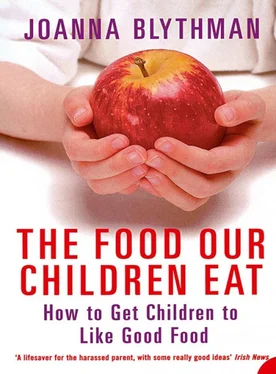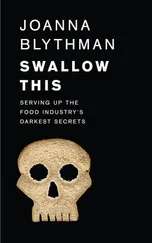Knowing how far this modern children’s diet is from any concept of good food, let alone healthy eating, an outside observer might assume that it is the prerogative of a poor and disadvantaged underclass that can’t afford to feed its children properly. But junk food is the great leveller. These days children from affluent backgrounds often eat as badly as their less privileged counterparts. The nation’s youth, it seems, is united in its attachment to junk.
Many parents recognise that they are not feeding their children the way they themselves were fed when young and they worry about this. But our anxieties are soothed by the overwhelming cynicism that surrounds the whole subject of feeding children. The fact that most children in the U K eat extremely badly has become institutionalised. Though new parents set out with good intentions, puréeing wholesome foods and vowing to be different, there’s a prevalent feeling that it’s only a matter of time till children graduate on to the modern crisps-and-cola, burgers-and-turkey-nugget repertoire. After all, they encounter it everywhere – at school, at friends’ houses, at the corner shop, on television.
The pressure on children to eat junk is so strong and so widespread that many parents simply throw in the towel. Why fight the inevitable, especially when no one else seems to be bothered? And there’s succour to be had from the feeling of safety in numbers, too. If all those freezer cabinets are full of pre-fried, re-formed bits of cheap animal protein targeted at children, surely they can’t be too bad? If the neighbourhood créche recommends crisps as a morning snack because fruit makes too much mess, who are we to stick out our necks and say differently? So many children live on this typical ‘children’s diet’ that surely it must be the norm?
Thus we live in hope that sooner or later, as though by magic, our offspring will be transformed miraculously into sensible adults with wide-ranging, sophisticated food tastes. We fondly imagine that burger-and-biscuit-addicted Kevin or Holly will turn into a marvellous eighteen-year-old who adores spinach salad, or stir-fried squid, aubergine and anchovies.
If you find those rationalisations comforting, then you may not want to read on. This book is for people who have the gut reaction that, however ubiquitous and common it might have become, the typical children’s diet is unacceptable. First, because it drastically limits children’s food horizons and therefore their ability to get pleasure from the delicious diversity of foods available, not to mention the sociable rituals that surround eating. Second, because it deviates so much from any notion of good nutrition that it stores up problems for their long-term health.
The core is that we need separate and different children’s food about as badly as we need a fatal illness. Instead, we should abandon the whole concept and reintegrate children into mainstream eating.
The ideas and strategies in this book are designed to help parents who want their children to eat better and who are prepared to put some effort into achieving that goal. The basic approach can work with children of all ages, even those who have already become accustomed to eating the typical children’s junk food. It is based on my knowledge as a specialist food journalist and my experience as a parent. The first has given me the conviction that we cannot afford to be passive about children’s junk because it amounts to a modern brand of malnutrition. The second has shown me that children can come to appreciate and actively desire a wide range of good, wholesome unprocessed food if the adults who feed them are committed to that idea.
My children, aged fourteen and ten, do not eat absolutely everything that I might as an adult, but they will eat, or at least try, most things. They have their likes and dislikes, as do adults. Mushrooms and aubergine get the joint thumbs-down. One refuses tomatoes but adores avocado; the other leaves the avocado and wolfs down the tomatoes. Nevertheless, they both eat a wide range of different foods from all food groups and there are no complete categories of food – such as vegetables – that are no-go areas. What pleases me most is that they actively enjoy eating. Meals aren’t just a refuelling exercise. They are enthusiastic eaters who approach even new foods with a positive and open attitude.
Some people wonder how they came to be this way. ‘ What did you do with them ?’ they ask. ‘ Mine won’t eat that way, your kids are different ,’ they remark. It’s an interesting cultural shift to see how children who eat reasonably widely and well have become the exception rather than the rule.
The answer is that there is absolutely nothing complicated, or even particularly demanding, about producing children who eat well. I have done nothing with my children that hasn’t already been done by generations of parents. The approach amounts to little more than common sense. It is just that these days, children’s junk food is so prevalent that parents think that the old laws of nutrition no longer apply. We need to be reminded of them.
So this book offers a common-sense strategy for getting children to eat better – one that also makes the job of feeding children easier, not harder. There are workable and effective strategies for every testing situation but, in essence, the approach is terribly simple.
HOW TO GET YOUR CHILDREN TO EAT WELL
• Feed children the same food you yourself eat.
• Socialise children into good eating habits by eating with them as much as you possibly can.
• Consciously open up children’s food horizons by introducing them to a wide range of tastes.
• Keep on presenting them with a wide range of foods even if they resist them at first: they will learn to like what they are given.
• Give them the freshest, most nutritious and best-quality food you possibly can.
This is the opposite of how many modern children eat.
HOW TO GET YOUR CHILDREN TO EAT BADLY
• Give them different food from that which you yourself eat.
• Feed them separately most of the time.
• Stereotype them as having narrow food horizons and therefore offer them only a limited number of foods.
• When they reject a food, do not offer it to them again consistently.
• Give them the most processed, least satisfying and least nutritious food around, otherwise known as ‘children’s food’.
The underlying assumption in the points above is that there is only one kind of food suitable for children – good food – and that the best way to deliver that is to socialise them into adult eating patterns and tastes from the time they are weaned. I firmly believe that the modern idea of separate children’s food, which assumes that children have different requirements from adults, is the enemy of good eating in the long term. By going down that ‘separate’ and ‘different’ road, food manufacturers have got away with transforming children’s food into a junk-food ghetto.
For this reason, I have deviated from other children’s eating guides by not including recipes for separate ‘children’s’ dishes. This book does, however, include recipes and meal ideas that should appeal to both adults and children alike; to my mind this is much more useful. It seems to me that children need to, and can, eat the same as everyone else.
Why? Because it’s much less time-consuming for the person preparing the food if there is just one meal on the go. Who can dream up and prepare two different sets of good meals each day for any length of time? If you adopt this way of doing things, then something has to give. What happens more often than not is that one ‘real’ meal is prepared for the adults and the children end up with reheated processed junk. So it seems to me that if we want children to eat well in the long run, we need to get them accustomed to eating the same as everyone else as early as possible rather than feeding them differently.
Читать дальше











